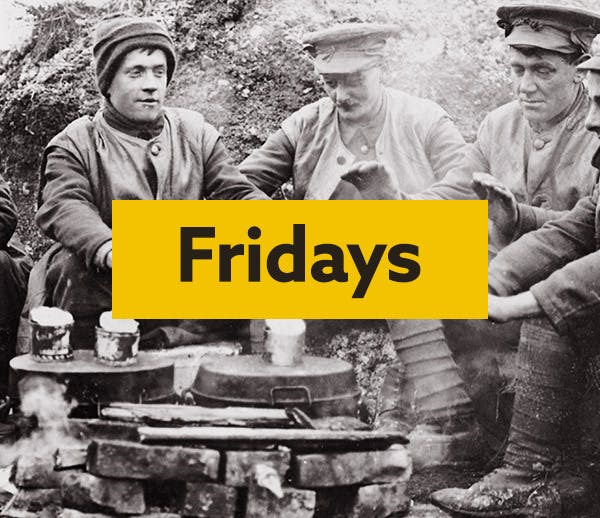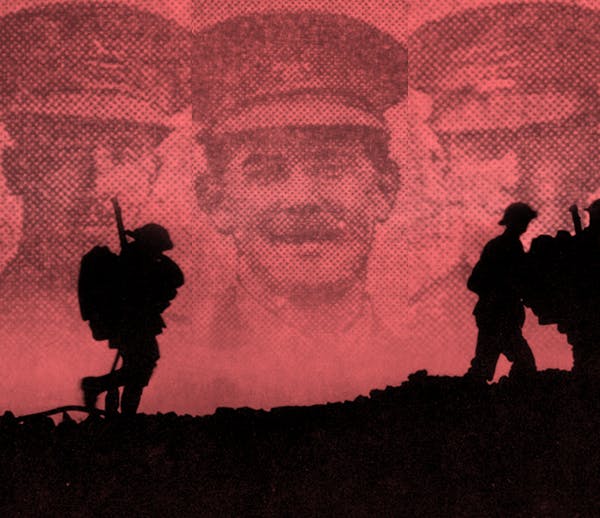Find your family's heroes
Bravery and brotherhood: the Grimsby Chums and World War 1
8-9 minute read
By Ellie Ayton | November 6, 2025
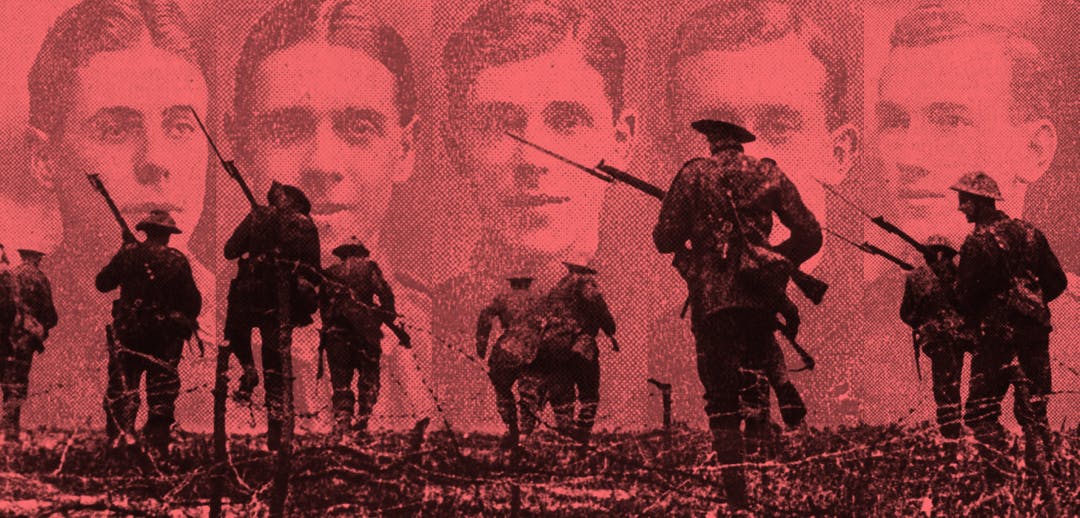
During the Great War, brothers, friends and workmates enlisted together and sacrificed together. This is the story of the Grimsby lads who answered Lord Kitchener's call during World War 1, as told through first-hand accounts, war diaries and military records.
Thousands of British men volunteered or were conscripted into the British Army during the First World War, with regiments raised across the country. But some regiments were different. Pals battalions offered men the chance to enlist alongside their friends, neighbors and colleagues - an extra incentive to go to war that proved popular in local communities.
Men fought shoulder-to-shoulder with their loved ones, but when Pals battalions suffered heavy losses, it had devastating consequences for the towns and cities left behind. This is the story of Grimsby's Pals.
The beginnings of the Grimsby Chums
In 1914, Grimsby was a proud Lincolnshire port city, bustling with the raw energy of steam trawlers and the salt-stained men who crewed them. Its docks rang with the clang of chains and the cries of fishmongers, while rows of brick houses sheltered families bound to the sea.
When Lord Kitchener first called for volunteers in 1914, the headmaster of a school in Grimsby raised a company of 250 former pupils, which was offered to the 5th Battalion Lincolnshire Regiment. After more Grimsby men showed enthusiasm to join, an entire new battalion was formed - the 10th Battalion Lincolnshire Regiment, which would affectionately become known as the 'Grimsby Chums' - the only Pals regiment to be called 'chums'.
Why 'Chums'? It's the language of schoolboys, conjuring images of innocence and loyalty. Recruiters knew this term carried weight, and it was a nickname that stuck.
Find your family's heroes
Delve deeper into military records
The regiment's war diary from The National Archives notes:
"The 10th Battalion Lincolnshire Regiment was raised by the Mayor of Grimsby, and recruiting commenced on 9 September 1914."
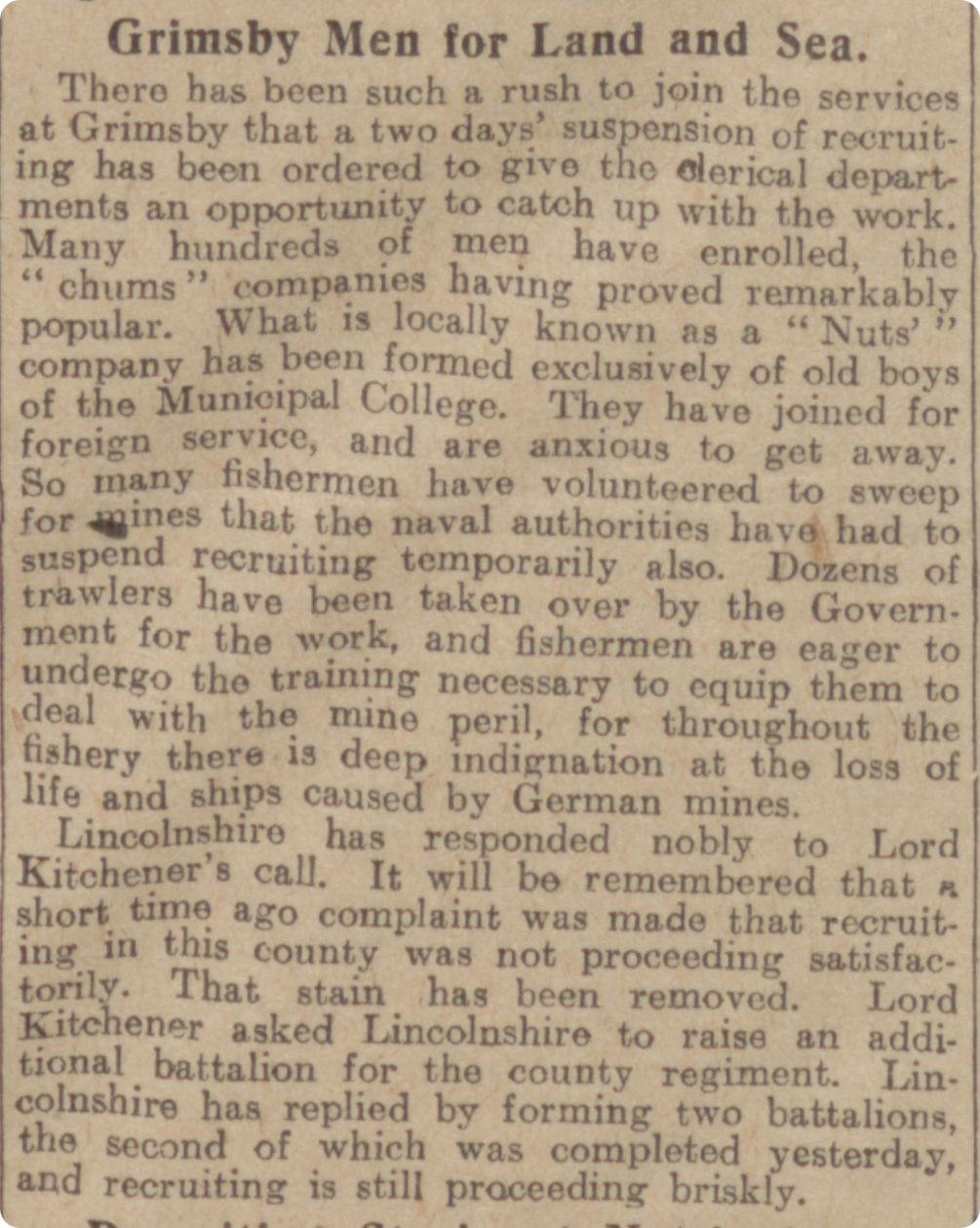
Men are recruited for 'land and sea' from the Sheffield Daily Telegraph, 10 September 1914.
On 17 September 1914, Alfred William Jaines enlisted in the 10th Battalion. He was a local lad, a ship's painter, and a keen sportsman from a big Mansel Street family. It's possible he lied about his age - his service record indicates he was born in 1895, but all other records suggest he was born in 1897. He was 17, rather than 19.
It wasn't just men from Grimsby either - volunteers from Boston, Louth, Scunthorpe and Wakefield also answered the call, and the soldiers went on to join the 101st Brigade of the 34th Division.
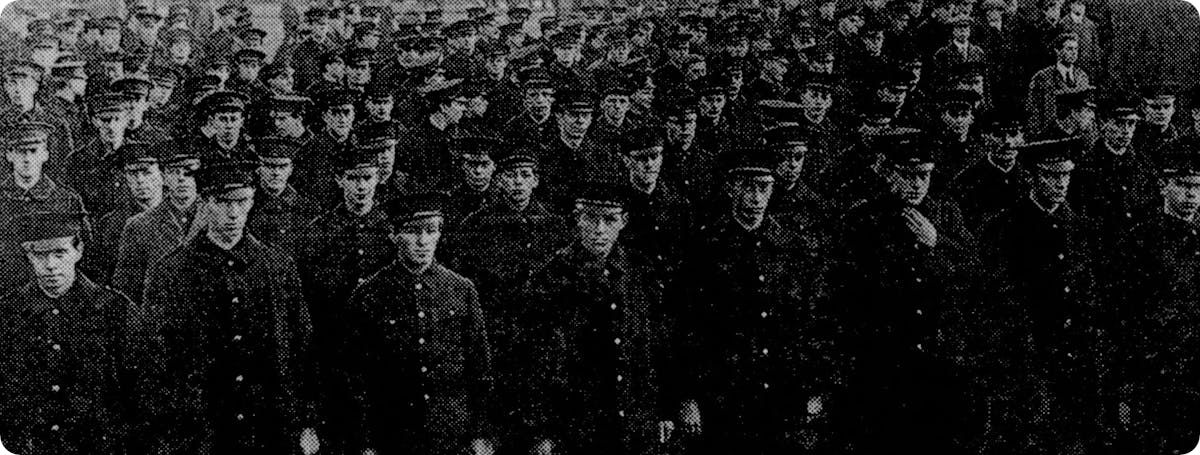
Chums on parade in 1914, wearing old Post Office uniforms as 'there wasn't enough Khaki to go around,' from the Grimsby Daily Telegraph, 26 June 1991.
In October 1914, Lieutenant-Colonel George Heneage wrote to the local newspaper with a letter, calling on 'ex-public school boys, members of athletic clubs, rifle clubs, tradesmen, farmers, gamekeepers, chauffeurs' and others to come forward.

A and B Company of the Grimsby Chums, from the Saturday Telegraph (Grimsby), 10 October 1914.
The newly-formed Chums left Grimsby in December 1914 for a training ground at Brocklesby. By this point, the 10th Lincolnshire Regiment also included dockworkers and shopworkers.
After some further training, the Chums were ready for battle. The men, some barely out of boyhood, had no experience of trench warfare, of battle, and few would have realized the mortal danger they were about to face on the frontlines.
Trench fighting and the Battle of the Somme
As Christmas 1915 approached, the Chums were preparing to leave for Egypt. But by Boxing Day, that plan was no more. The regiment diary writes: 'Sun helmets withdrawn. Fast disappointment in all ranks.' Instead, by January 1916, the Chums were in Wardrecques in Northern France. Alfred's service record tells us he embarked for France on 9 January.

An extract from Alfred's service record, which indicates his movements during the First World War. You can explore his full record here.
From there, the Chums were on the move. Both companies of the 10th Lincolnshires first experienced the mud and cold of the trenches at Erquinghem on 2 February, and one man was wounded.

A map of the trenches from the Chums' war diary, WO 95/2457-01, The National Archives.
Between February and June 1916, the Chums were in and out of the trenches along the Western Front, marching between locations such as Bresle and Albert. At Albert on 29 June 1916, the diary notes:
"This was the fifth day of the British artillery bombardment of the German trenches, which commenced on the 24th. Lieutenant W R Wrote of C Company was killed by shell fire on this day. He was the first officer of the battalion to be killed since the battalion went on active service."
From here, the war diary becomes more detailed. The deadliest battle in the history of the British Army was about to commence - the Battle of the Somme.

Officers of the Grimsby Chums, pictured in the Grimsby News, 1 September 1916.
The war diary of the 10th Battalion Lincolnshire Regiment relays the events of 7:30am on 1 July:
"Two minutes before the attack was timed to take place, a mine was exploded near the south-west corner of the La Boiselle salient, forming an immense crater almost 100 yards in diameter."
We can almost hear the roar of the guns, the cries of the men as they went over the top into No Man's Land near Becourt, France.
"On leaving the trenches, the 10th Lincolns who advanced... were immediately subjected to heavy shell fire, shrapnel... and the most intense machine gun fire... Advancing with the utmost steadiness and courage, not to be surpassed by any troops in the world..."
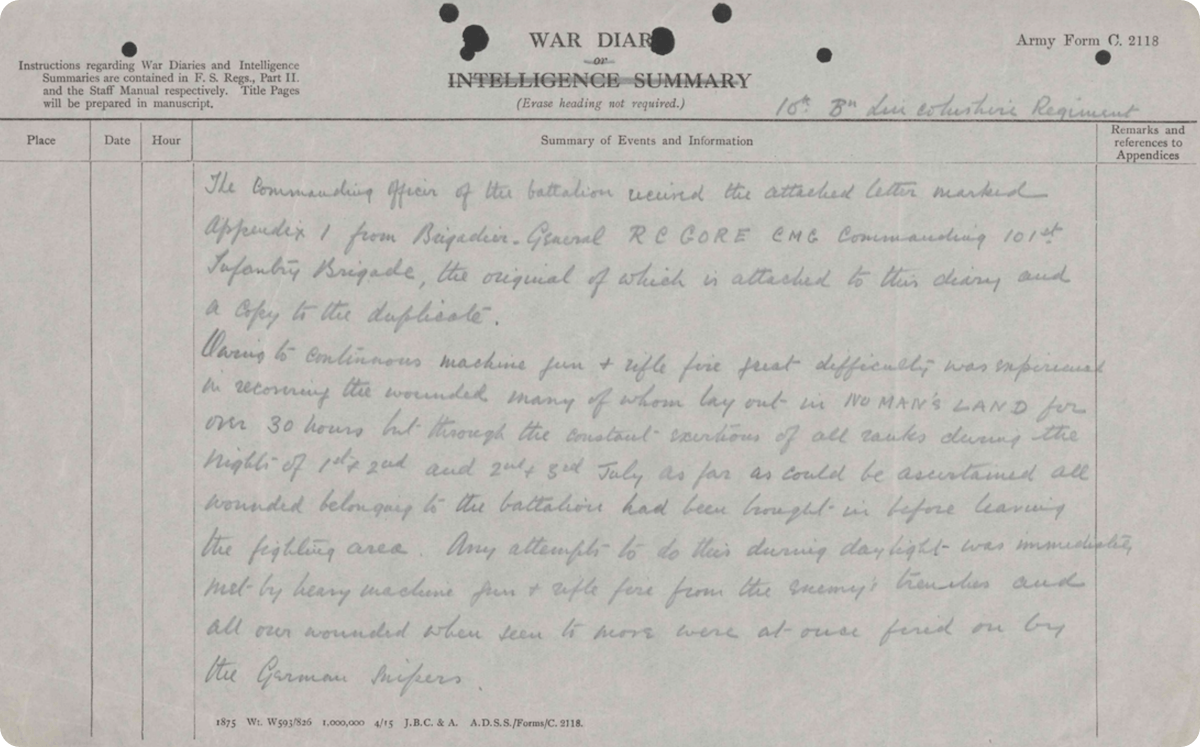
An extract from the diary of the 10th Battalion Lincolnshire Regiment, shortly after the Battle of the Somme. WO 95/2457/1, The National Archives.
The Chums went into battle with 20 officers and 822 other ranks. The diary goes on to mention the names of the officers (those who died, were wounded or missing) and:
"...owing to continuous machine gun and rifle fire, there was great difficulty in recovering the wounded, many of whom lay out in NO MAN'S LAND for over 30 hours."
Some of the Chums officers - Anderson, Jolin, and Hendin - were awarded the Military Cross for their actions on 1 July. Brigadier General Gore wrote to the Battalion's commanding officer, Colonel Cordeaux, writing:
"Will you please express to your Battalion my admiration of their fearless conduct in the battle on July 1st... No troops could have done better."
In 1995, an old film of the Chums in training was found. The film was shown at the local cinema in July 1916, the seats filled with mothers, wives, and children desperate for a glimpse of their boys. The viewing took place just three days after the devastating first day of the Somme.
In the aftermath, the diary remarked:
"Trenches in very bad condition... many unburied dead about."

Pte Jaines went missing after 1 July. His family published this photo in the Grimsby News, 11 August 1916.
His name also appeared in a long list of missing soldiers a week later.
Local newspapers, such as the Grimsby News and the Grimsby Telegraph, published photographs of the fallen and the missing, like Private Jaines.
In June 1917, Alfred's personal items were returned to his father, including two identity discs, four letters, 16 photos and two cards. A note was added to his service record: 'deceased'.
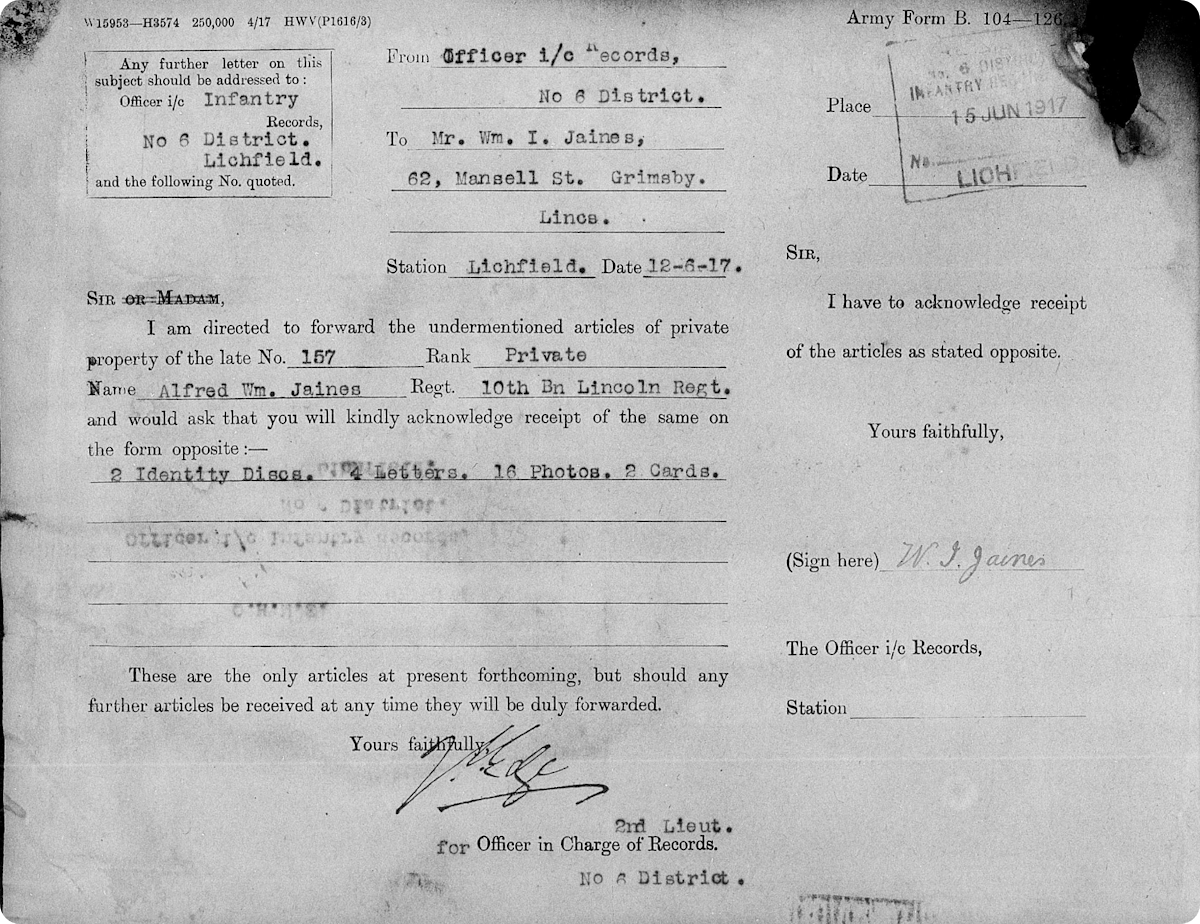
An extract from Alfred's military service record. View the full record here.
For those who survived 1 July, trench warfare in France continued. In September 1916, they were ordered to raid German trenches without badges, letters or maps, and with blackened faces, told to capture a prisoner and to 'do as much damage as possible.' The raid took place in the early hours of 1 October.
Armistice Day, 11 November 1918, is not recorded in the war diary. By February 1919, demobilization was in progress. The final entry on 3 June 1919 reads:
"The Battalion cadre was finally disbanded today."
A long war. A tragic human cost.
The Grimsby Chums after the war
After the loss of life at the Somme, many towns lost an entire generation of men. Pals battalions were no longer raised.
As the war ended, Grimsby and Cleethorpe were quiet. Almost 1,000 of their young men had been lost on the Somme alone. On the 80th anniversary of the battle, one article said:
"Their sacrifice broke the heart of their commanding officer. And it broke the heart of Grimsby. In truth it broke the nation's heart and never again were volunteer battalions raised in the same way. For the loss to community was too concentrated and too great."
A memorial in St James' Church, Grimsby, was erected in memory of the 810 members of the Grimsby Chums who lost their lives during World War 1.
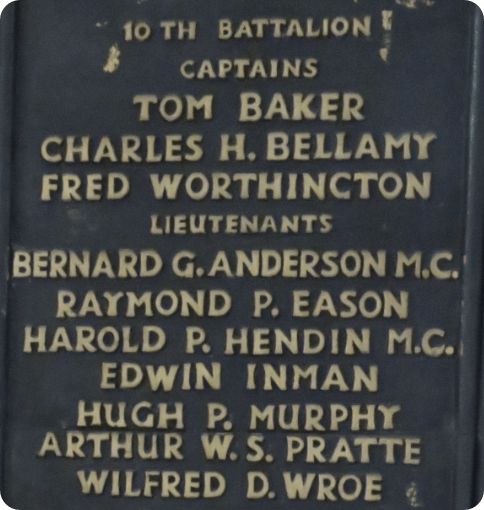
Some of the fallen officers on the Chums memorial in St James' Church. You can view this in full here.
The fallen Chums were buried in cemeteries or immortalised on memorials along the Western Front, including the Roeux British Cemetery, the Etaples Military Cemetery, and the Bapaume Post Military Cemetery in Albert.
Private Jaines is remembered on the Chums Memorial at St James Church and on the Thiepval Memorial. His mother, Jessie, died aged just 38 in 1918.
Former Chums continued to meet up every year following the war, particularly on 1 July to honor those who fell on that fateful day.

The Chums honor their fallen comrades, from the Grimsby News, 5 July 1929.
Even with a proud past, the history of the Grimsby Chums remains scattered and half lost. But together, we can ensure the stories of these men are remembered exactly where they should be: side by side.
How to discover if your ancestor was a Grimsby Chum
By searching for your ancestor's name in our military records, you can discover the regiment and battalion they served in. For the Grimsby Chums, you'll want to look out for the 10th Battalion Lincolnshire Regiment on your ancestor's record - that will indicate they were a Chum.
If your relative sadly never made it home, you can find burial and memorial details for the Chums using the Commonwealth War Graves records.
Thank you to our community members in the Findmypast Family History Forum, who suggested which Pals battalions we should explore. Now you've read the story of the Grimsby Chums, you can delve deeper into the tales of the Bradford Pals and the Liverpool Pals.


